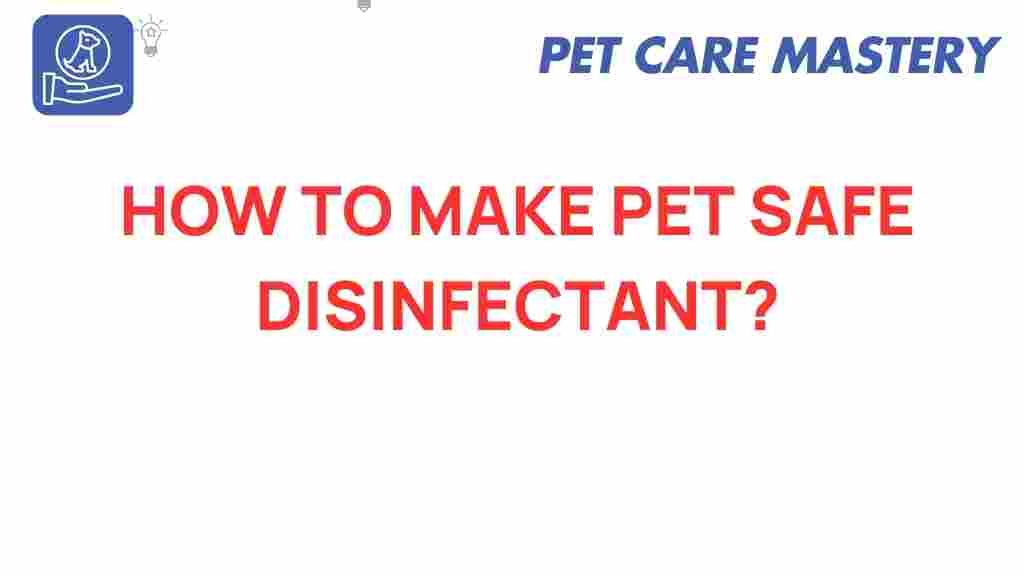Pet-Safe Disinfectants: Unleashing the Secrets
As pet owners, we often find ourselves in a dilemma between keeping our homes clean and ensuring our furry friends are safe. Traditional disinfectants can harbor harmful chemicals that may pose risks to our pets. This is where pet-safe disinfectants come into play. In this article, we will explore the secrets to finding and using disinfectants that are safe for your pets, ensuring a clean and healthy environment for your beloved companions.
Understanding Pet-Safe Disinfectants
Before diving into the types of pet-safe disinfectants, it’s essential to understand what makes a disinfectant safe for pets. The key factors include:
- Non-toxic ingredients: Avoid disinfectants that contain harmful chemicals, such as bleach, phenols, or ammonia.
- Natural alternatives: Many pet-safe disinfectants utilize natural ingredients, such as vinegar, baking soda, and essential oils.
- Fast-acting and residue-free: Look for products that dry quickly and leave no harmful residue behind.
Why Choose Pet-Safe Disinfectants?
Choosing pet-safe disinfectants is crucial for several reasons:
- Protects your pets from harmful chemicals that can lead to illness.
- Reduces the risk of allergic reactions or skin irritations.
- Creates a safer environment for both pets and humans.
- Maintains a clean home without compromising your pet’s health.
Types of Pet-Safe Disinfectants
There are several types of pet-safe disinfectants available on the market. Here are some popular options:
1. Vinegar and Water Solution
Vinegar is a natural disinfectant that can effectively kill bacteria and viruses. To create a vinegar solution:
- Mix equal parts of white vinegar and water in a spray bottle.
- Spray the solution on surfaces and let it sit for a few minutes before wiping it away.
2. Baking Soda
Baking soda is another safe disinfectant that can neutralize odors and clean surfaces. To use:
- Sprinkle baking soda on the surface.
- Let it sit for 10-15 minutes to absorb odors.
- Wipe it off with a damp cloth.
3. Essential Oil Disinfectants
Some essential oils, such as tea tree oil and lavender oil, have natural antibacterial properties. However, ensure they are safe for pets before use. To create an essential oil disinfectant:
- Add a few drops of pet-safe essential oil to a spray bottle filled with water.
- Shake well and spray on surfaces, avoiding areas your pets frequently contact until it dries.
4. Commercial Pet-Safe Disinfectants
There are also several commercial products specifically formulated to be pet-safe. Look for products that are labeled as non-toxic and biodegradable. Some trusted brands include:
Step-by-Step Process for Using Pet-Safe Disinfectants
Using pet-safe disinfectants effectively requires a few simple steps:
Step 1: Prepare the Area
Before disinfecting, remove any pet toys, bedding, or food bowls from the area. This ensures that your disinfectant can work effectively without interference.
Step 2: Choose Your Disinfectant
Select one of the pet-safe options mentioned above. If you’re using a commercial product, read the label for specific instructions.
Step 3: Apply the Disinfectant
Spray or apply the disinfectant generously on the surfaces you wish to clean. Ensure even coverage, focusing on high-touch areas like doorknobs, countertops, and pet areas.
Step 4: Let it Sit
Allow the disinfectant to sit for the recommended time to kill germs effectively. This can range from a few minutes to up to 10 minutes, depending on the product.
Step 5: Wipe Down
After the appropriate time has passed, use a clean cloth to wipe down the surfaces. Make sure to remove any excess product to avoid residue.
Step 6: Rinse (if necessary)
If you used a solution that requires rinsing, such as vinegar, rinse the area with clean water after wiping it down.
Troubleshooting Pet-Safe Disinfectants
While using pet-safe disinfectants is generally straightforward, you may encounter some challenges. Here are troubleshooting tips:
Problem: Lingering Odor
If you notice a strong smell after disinfecting, try:
- Increasing ventilation by opening windows or using fans.
- Using baking soda to neutralize odors, as mentioned earlier.
Problem: Stains Persist
For stubborn stains that remain after disinfecting:
- Consider using a mixture of vinegar and baking soda as a paste to scrub the stains.
- Allow the paste to sit for 15 minutes before wiping it away.
Problem: Pet Reactions
If your pet shows signs of discomfort after cleaning, such as sneezing or excessive licking:
- Immediately remove them from the area.
- Consult your veterinarian for advice on potential allergies.
Conclusion
Maintaining a clean home while keeping your pets safe is entirely achievable with the right knowledge and tools. By using pet-safe disinfectants, you can protect your furry friends from harmful chemicals while ensuring a hygienic living space. Remember to always read labels, test any new product in a small area first, and consult your veterinarian if you have concerns about specific ingredients. With these tips and tricks, you can unleash the secrets to a cleaner, safer environment for both you and your beloved pets.
This article is in the category Products and created by PetCareMastery Team
